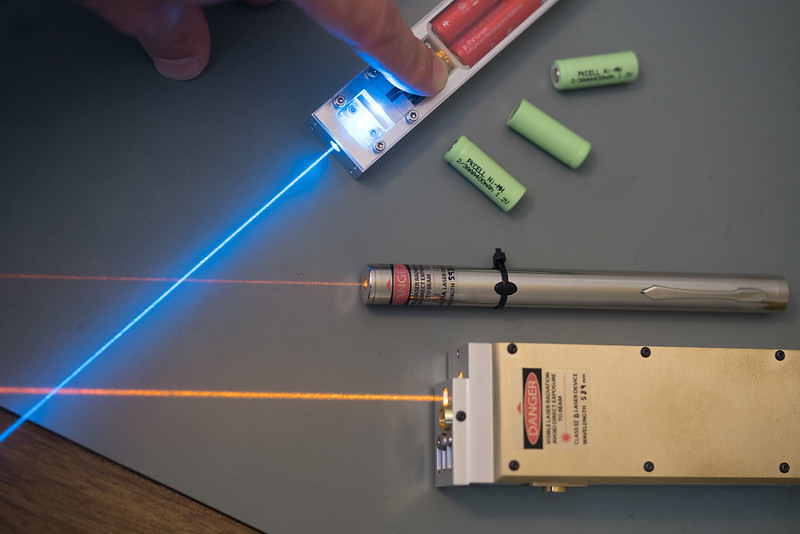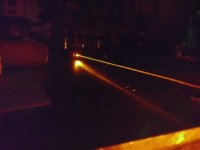- Joined
- Sep 16, 2007
- Messages
- 3,660
- Points
- 113
Who would have guessed an extremely rare wavelength would just magically appear within reach?
Here's a place to compile our information and photos. I'll start:
I got a couple of these 593.5 nm modules. I plan to make a special host but for now I slapped one into a chrome pen (the quick and easy way to get it running).
These modules are oversized a bit - 12.1 mm diameter at the widest point, which on mine is just at the shoulder before the threaded aperture begins.
I removed the "front half" of the brass module. It looks very much like the typical inexpensive 532 nm pointers with a set of crystals sandwiched between a diode with collimating optics, and a convex lens to diverge the beam before it's collimated with a converging lens. Are the crystals hygroscopic? I don't know. However, I haven't noticed any degradation in performance. I live in dry southern California.
To get the module into the chrome pen host, I had to reduce the diameter of the module so I took the "front half" from the module, covered the lens from both sides, chucked it in the machine and used a good file to shave off the external threads around the aperture and took 0.2 mm off the front shoulder. Now it fits perfectly.
I also added a plastic bendy thing to make the button easier to press, since it doesn't perfectly align with the hole in the host. No problem with the plastic bendy thing.
Anyway, I'm powering mine with 3 400mAh 1.2-1.4V NiMH 2/3 AAA cells. These 2/3 AAAs are really nice for boosting the voltage in pen builds without going to Li-Ion. It beats using a spacer and a single 10440.
For both of my modules I get 5-10 mW. Some of this is IR but I can't accurately measure how much because my IR cut filter also reflects something like 30% at 593 nm. I need a higher resolution LPM to measure these lasers. When cold, I get less than 1 mW of 532 nm and 17 mW of IR. When the laser comes to temperature, the IR starts to drop off, then the light is converted to a brilliant amber yellow. Really nice color. This will be perfect as a presentation pointer for my next conference (science conference because I'm a real scientist ).
).
OK- some photos next to my 589 nm 20 mW laser.
It's very similar to 589 nm but noticeably more orange. The visual difference in color between 589 and 593.5 nm is more than the difference between 660 and 638 nm but less than the difference between 488 and 495 nm.



Here's a place to compile our information and photos. I'll start:
I got a couple of these 593.5 nm modules. I plan to make a special host but for now I slapped one into a chrome pen (the quick and easy way to get it running).
These modules are oversized a bit - 12.1 mm diameter at the widest point, which on mine is just at the shoulder before the threaded aperture begins.
I removed the "front half" of the brass module. It looks very much like the typical inexpensive 532 nm pointers with a set of crystals sandwiched between a diode with collimating optics, and a convex lens to diverge the beam before it's collimated with a converging lens. Are the crystals hygroscopic? I don't know. However, I haven't noticed any degradation in performance. I live in dry southern California.
To get the module into the chrome pen host, I had to reduce the diameter of the module so I took the "front half" from the module, covered the lens from both sides, chucked it in the machine and used a good file to shave off the external threads around the aperture and took 0.2 mm off the front shoulder. Now it fits perfectly.
I also added a plastic bendy thing to make the button easier to press, since it doesn't perfectly align with the hole in the host. No problem with the plastic bendy thing.
Anyway, I'm powering mine with 3 400mAh 1.2-1.4V NiMH 2/3 AAA cells. These 2/3 AAAs are really nice for boosting the voltage in pen builds without going to Li-Ion. It beats using a spacer and a single 10440.
For both of my modules I get 5-10 mW. Some of this is IR but I can't accurately measure how much because my IR cut filter also reflects something like 30% at 593 nm. I need a higher resolution LPM to measure these lasers. When cold, I get less than 1 mW of 532 nm and 17 mW of IR. When the laser comes to temperature, the IR starts to drop off, then the light is converted to a brilliant amber yellow. Really nice color. This will be perfect as a presentation pointer for my next conference (science conference because I'm a real scientist
OK- some photos next to my 589 nm 20 mW laser.
It's very similar to 589 nm but noticeably more orange. The visual difference in color between 589 and 593.5 nm is more than the difference between 660 and 638 nm but less than the difference between 488 and 495 nm.


















